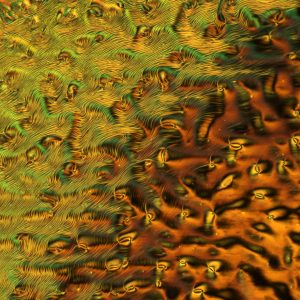Ordered Liquid Crystal Nanocomposites Illuminated by Polarized Optical Microscopy
An ongoing point of research in the Composto Lab is ordering anisotropic nanoparticles inside of a polymer matrix to control a wide array of composite properties. The Osuiji group lends expertise in liquid crystal polymers (LCPs), a unique class of soft matter materials, that have the ability to readily align under external stimulus (e.g., mechanical shear and magnetic or electric fields). Importantly, the LCPs can be crosslinked to quench their alignment along a single axis, the nematic director. Upon incorporation of 2-D materials (e.g., graphene oxide or molybdenum disulfide nanosheets), the LCP alignment induces ordering of the nano-filler, an outcome that is not readily achievable using traditional processing methods. Polarized optical microscopy (POM) can be used to visualize the textures that result from the birefringence of the sample, and to investigate the ordering of the liquid crystal nanocomposites. Funded by a MRSEC seed grant, master’s student Alexander Grun, working jointly with Liu Xuanbo, Shawn Maguire, as well as Uri Gabinet of the Osuji lab, fabricated LCP composites containing graphene oxide and imaged their texture using POM as shown in the image. Here, a semi-ordered LCP composite exhibiting Schlieren textures achieved through mechanical shear alignment is displayed. Inhomogeneities in the applied field resulted in non-unidirectional, or local, ordering, evident by the wavy texture. With this preliminary research, we have begun to advance our understanding of complex liquid crystalline-based composite materials that lend themselves to advanced applications including thermotropic actuators and mechanotropic transducers.
Documented in Alexander Grun’s Masters Thesis in MSE (2020) entitled Magnetically Ordered Liquid Crystal Polymer Nanocomposites with Embedded with Graphene Oxide.
Beautiful Science page

